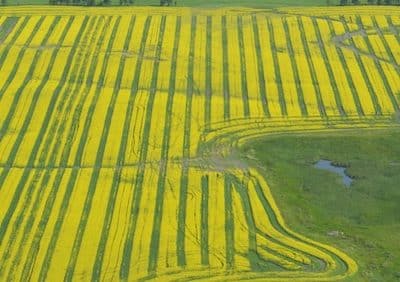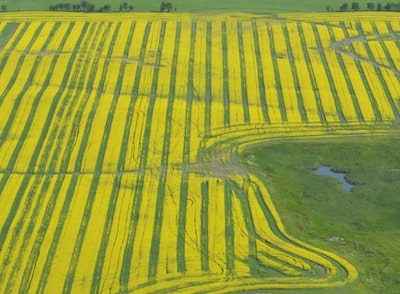We have reports of lots of patchy uneven canola fields this year. Here are our top 10 reasons, in no particular order.
1. Soil compaction. Soil compaction tends to be worse in fields seeded into muddy soil, and soil compaction could be one reason for patchy fields in the eastern Prairies this year. The freeze-thaw, expansion-contraction (cryoturbation) cycle of winter may be enough to alleviate compaction, especially in fields without a history of compaction problems.
2. Drowned out low spots. This is another factor of a wet spring. Canola plants may have emerged in low spots, but were stunted by subsequent heavy rains.
3. Heavy growth in low spots. Dry conditions may have prompted heavier growth in low spots, with thin patchy growth on higher ground.
4. Sulphur deficiency. Sulphur levels tend to be highly variable across a field, so fields with deficient sulphur in some areas can result in patchy growth.
5. Soil moisture holding capacity. Some fields have highly variable soil types, with clay patches holding moisture better than sandy and loamy patches. This variable moisture holding capacity will show up as patches in fields short of moisture. Note that fields with variable soil types can also have patches that result from nutrient deficiencies, salinity and other factors specific to soil condition.
6. Cutworms. Early season cutworm damage tends to occur in patches, and patches set back early may never catch up, producing a patchy crop at harvest.
7. Poor early season stand establishment. This can haunt a crop all season long. Various factors are at play, including variable seeding depth, uneven residue, and excessive seed-placed fertilizer. A crop that does not start off the season with even vigorous emergence can create a challenge for harvest timing.
8. Drill/seeder malfunction. Plugged distribution hoses, mudded up openers, worn openers, broadcast disasters — you name it — created all sorts of messes for seed placement or product distribution. Repeatable patterns through the field are often clear signs of some machinery problem.
9. Clubroot. Clubroot tends to expand through a field in patches created as field equipment moves infested soil from the original source infection sites. The result can be pre-mature ripening in infested patches and later (natural) maturity for other areas.
10. Blackleg. As a new virulent blackleg pathotype overtakes a field, it often starts in small patches and can slowly spread throughout a field unless the grower adopts blackleg management practices. While digging up plants to check for clubroot galls, also clip steps looking for blackleg.
Got another vote? Click the “Follow up question” link below to send us an email, or tweet a link to this article and add your “choice 11” in the tweet.


